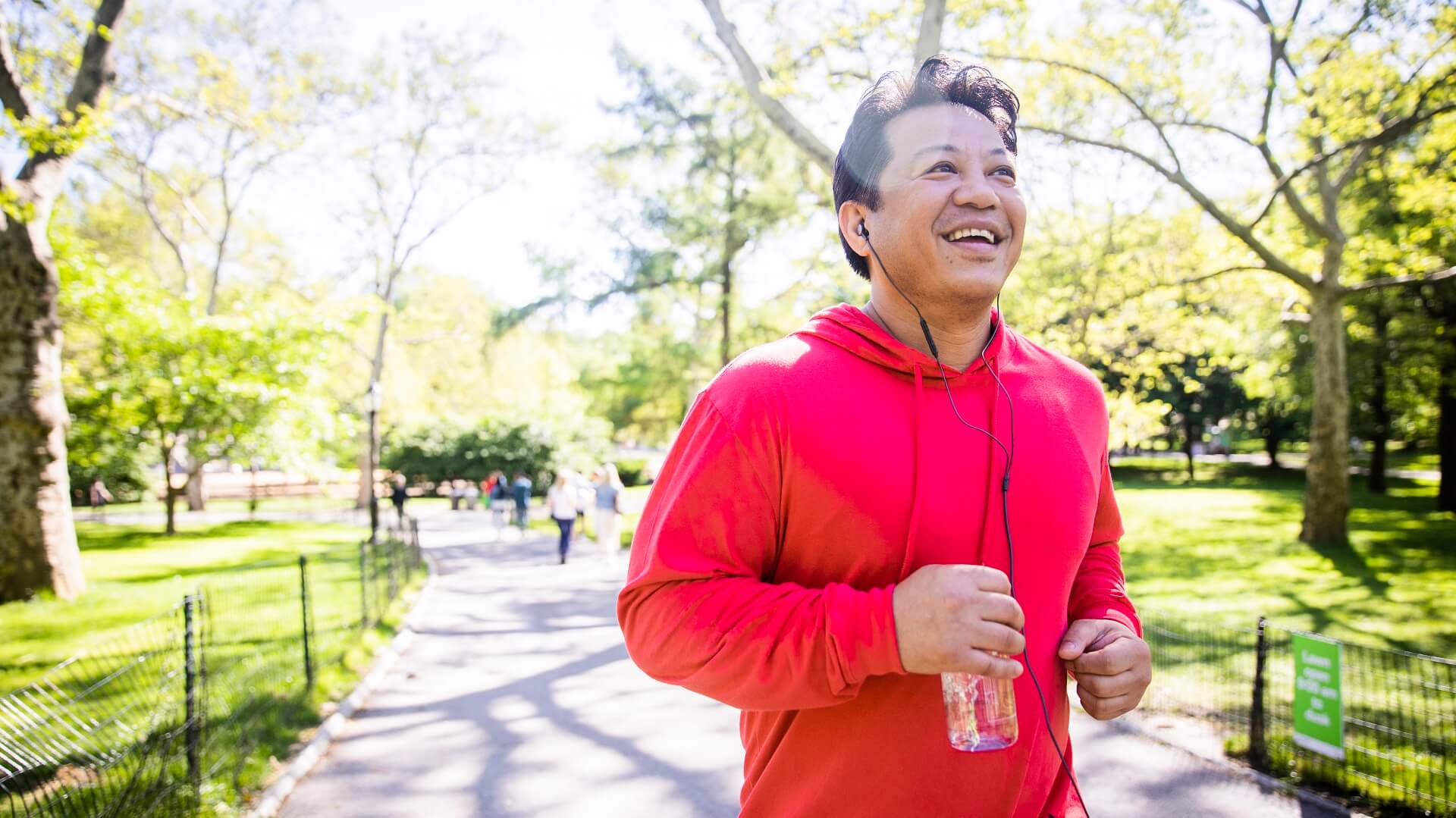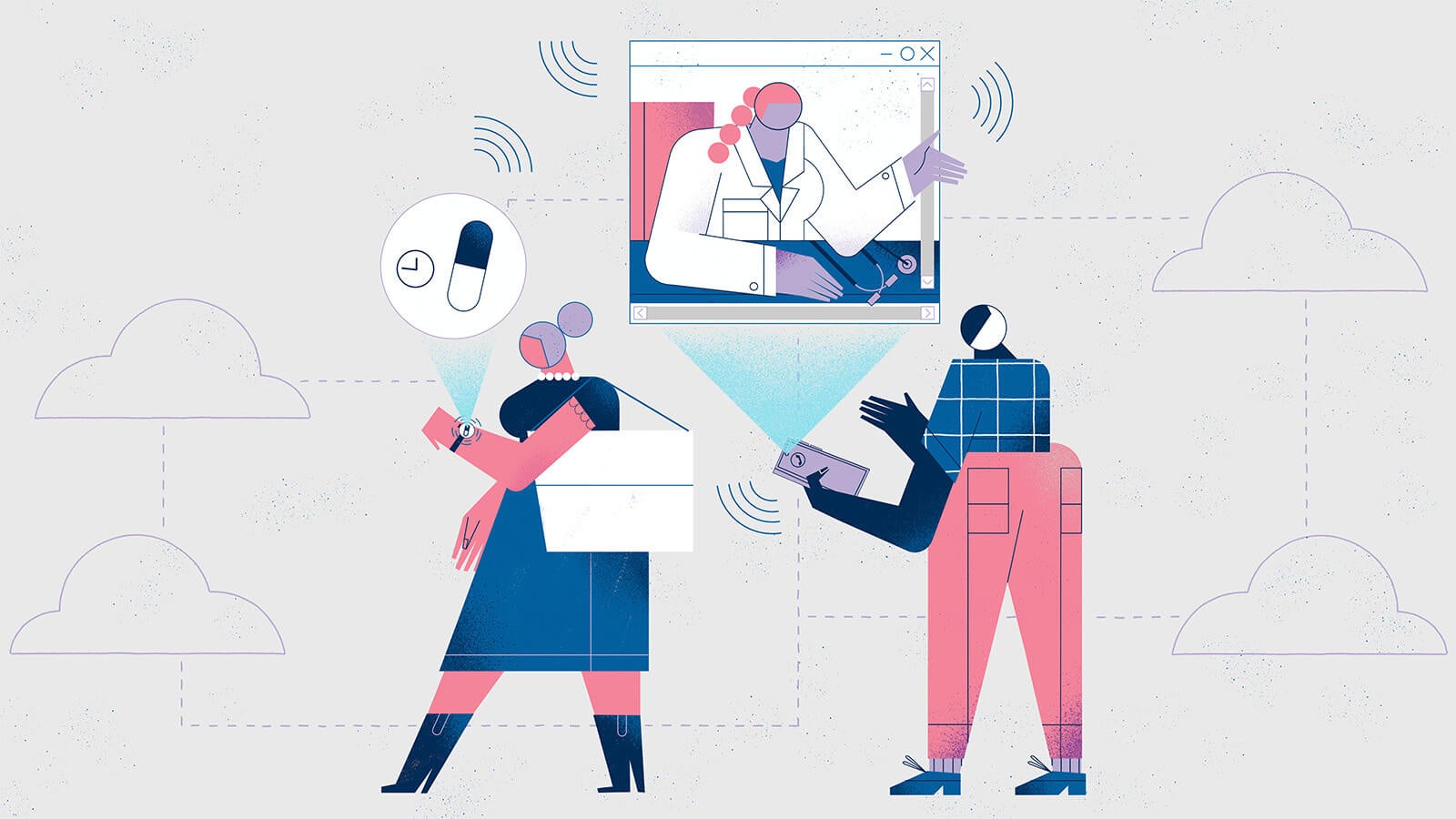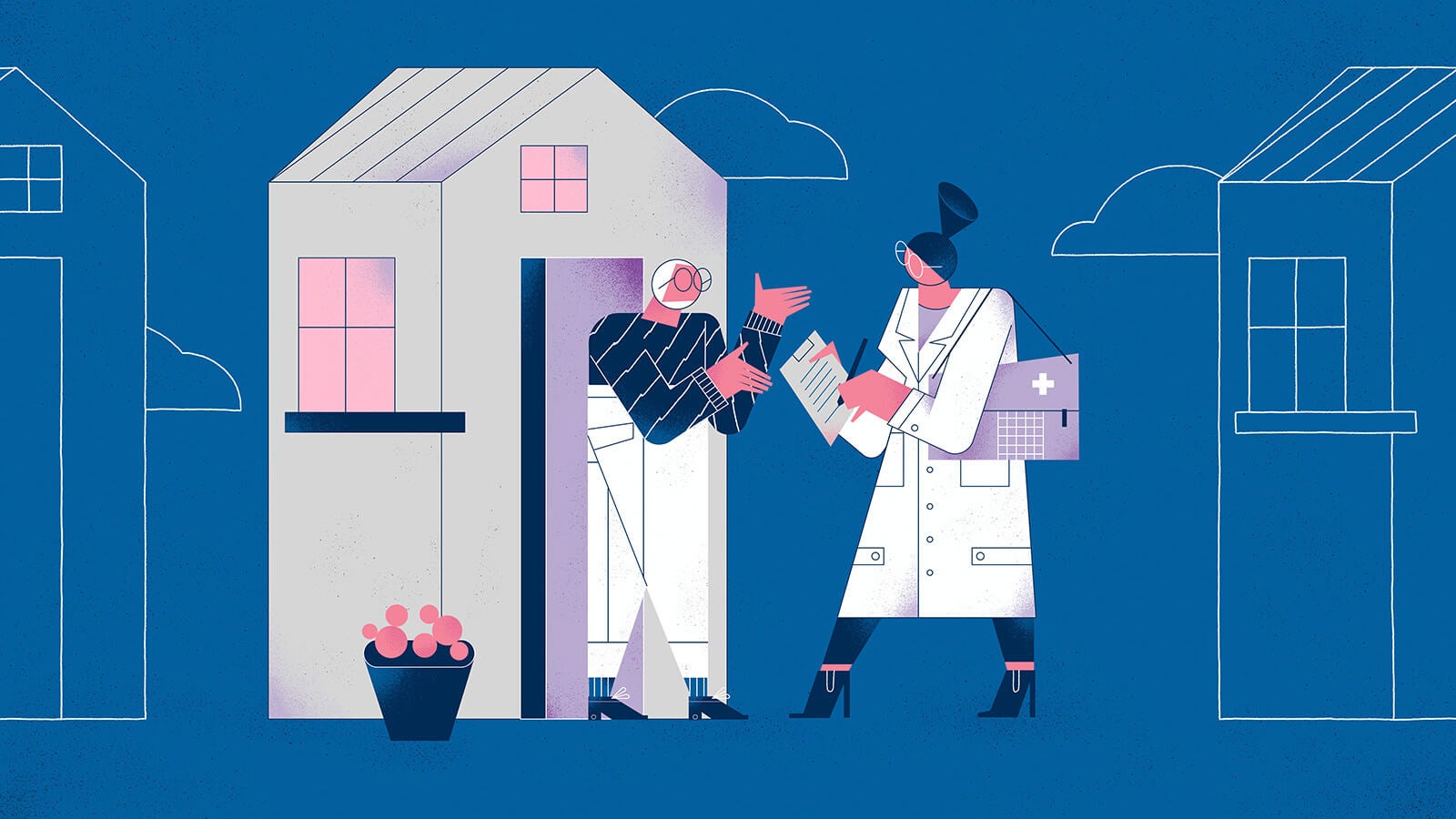Unlike in decades past — when about 40% of health care in America was delivered at home — only one percent of care is received at home today. Most older adults would like to reverse that trend, according to survey data published in the latest Health Trends report from CVS Health®, The Future of Healthy Aging. Four out of five older adults would prefer to get health services at home because it’s convenient and comfortable, says Dr. Sree Chaguturu, Executive Vice President and Chief Medical Officer, CVS Health®. What’s exciting, he notes, is the innovation in how we deliver home care and the range of services available, from acute care services like ‘home hospital’ to chronic disease management and even home hospice. “How do we make sure that we have services in a home that help enable your health care experience?”
Helping older adults receive at-home and local care
The benefits of an in-home evaluation
One way to improve the patient experience is through a professional in-home evaluation. Signify Health, recently acquired by CVS Health, has performed more than 2.5 million evaluations to assess the health risks of older adults. They spend time with each patient to understand their needs and share that information with providers, primary care teams and health plans. “Part of that in-home health evaluation is to ask the patient to bring out all of their medications,” Chaguturu explains. “What you see is that patients will get medication prescribed from all sorts of sources of care — from an urgent care, from their primary care team, after discharge from a hospitalization. And it can become incredibly confusing for a patient to understand exactly ‘what medications should I be taking,’ and ‘what are they doing for me?’ It’s really fundamentally basic but so important in making sure that a patient gets the care that they need.”
It’s incredibly simple but fundamental — by just spending time in a patient’s home, it really allows us to make sure that that patient is getting what they need, and it’s customized for their particular health situation.
Sree Chaguturu, MD
Executive Vice President and Chief Medical Officer at CVS Health
How seeing patients at home can improve care
To illustrate how having access to a patient’s home can improve care, Chaguturu told a story from his own clinical practice. His patient kept being readmitted to the hospital for heart failure, and Chaguturu kept changing medications to improve his condition. But one day, he had the opportunity to visit the patient’s house. While there, he asked about the patient’s diet — a question he says he may not have asked in the clinic. “He opened up his freezer, and it was full of Salisbury steak TV dinners. These are full of salt, and if you eat salt with heart failure, your condition is going to get worse. And the light went off in my head. It was that insight from the home that helped me be a better doctor for my patient.”
Learn more
Dr. Sree Chaguturu (00:00):
It's incredibly simple but fundamental. By just spending time in a patient's home, it really allows us to make sure that that patient is getting what they need and it's customized for their particular health situation.
Dr. Daniel Kraft (00:17):
Welcome to Healthy Conversations, an original podcast from CVS Health. I'm Dr. Daniel Kraft. The American population is getting older. One in five people will be retirement age by 2030, and their health care needs are expanding. The latest health trends report from CVS Health, called The Future of Healthy Aging, explored this issue in detail. And the report looked at the health of older Americans and what they need from the healthcare systems as they age. To help us consider how we meet these needs, I'm joined by Dr. Sree Chaguturu, executive vice president and the chief medical officer for CVS Health. Sree, I'm pleased to have you back on Health Conversations.
Dr. Sree Chaguturu (00:53):
It's always a pleasure.
Dr. Daniel Kraft (00:54):
Can you sort of touch on meta trends on care at home and the older population that you've been seeing across the care continuum?
Dr. Sree Chaguturu (01:01):
There's been a lot of exciting innovation in home care. But if we go back maybe 60 years or so, 40% of health care in America was delivered at home. You know, today, it's only about 1% of care is delivered at home? So, there's been this massive shift away from home. But when you ask people, especially seniors, "Where would you like to get care," four out of five individuals would say, "I would like to get care at home. It's convenient, it's comfortable, it's what I know, and much of what I have to go into the clinic probably could be delivered at home as well."
(01:42):
And so, what's exciting now is that people know, especially after COVID-19 and the pandemic, that the home can be a safe, ideal, place for delivering care, that there's a lot of innovation in how we deliver that. They can come in a variety of ways, acute care services like home hospital, or post-acute services, so transitions post-hospitalization or transitions in care. Or chronic disease management, how do I provide home services to help you manage your diabetes or your high blood pressure, for example. Home hospice, so dying at home with dignity. Also, what we would call home enablers, how do we make sure that we have services in the home that help enable your health care experience? And what I can tell you, Daniel, is that I don't know if we'll get back to that 40% that we saw in the 1960s, but what I think we're gonna do is move from 1% to a much more care being delivered at home with all of the innovation that's happening today.
Dr. Daniel Kraft (02:49):
Yeah, we're not quite back to the Dr. Welby model. But what do you think is underlying this ability to shift care to home and beyond?
Dr. Sree Chaguturu (02:57):
Technology, data analytics, changing consumer preference, that's what it is, Daniel. You just pointed out a lot of the technology and analytics that allow us to be able to provide care at home. We have more sensors, we have more data collection. We used to be you had one patient record, your record that would be in one location. But now, somebody who's at home can see the same data that somebody that might've been in a traditional care setting could see, so that your information is seamless and we can continue that care pathway that you're on. So all of that technology, data analytics, and changing consumer preferences what will drive this increasing adoption.
Dr. Daniel Kraft (03:41):
Also requires some adoption from clinicians. You know, we're all in this era of big data, but the clinician doesn't necessarily want more data, they want the insights and have to integrate into workflow. Have you seen some solutions work to increase that sort of connectivity and so you're not being overwhelmed as a clinician with, you know, blood pressure numbers, but the insights about the individual patient or your patient population?
Dr. Sree Chaguturu (04:03):
You know, how do you make signal out of noise, and how do you make sure that we can alert the clinical team? And I use that term clinical team purposefully as opposed to just your primary care physician. Now we see primary care physicians in value-based care being supported by a nurse, a nurse practitioner, or a physician assistant, or financial support specialist, a behavioral health support specialist, a care team that's looking at that data. So, you know, what we're gonna see is not only technology and analytics that helps us parse out signal to noise but a care model that makes sure that the physician is supported, that they're not the only one having to look at this data, but that there are others who are helping to integrate that data into your care journey. So, a lot of innovation's happening in that space.
Dr. Daniel Kraft (04:57):
So, we're in the era of, you know, uberization, pressing a button, getting what you want, whether it's a meal or your drive to a location, and that's coming to the realm of health care. CVS has acquired Signify Health, which certainly makes home care easier for both the clinician and patient. Can you tell us a bit about that Signify Health platform and how it's enabling patients and providers?
Dr. Sree Chaguturu (05:21):
We're really excited to welcome Signify Health to the CVS Health family. At its core, it's about helping individuals, providers, and health plans understand a patient's health risk by going into the home and spending over an hour with that individual understanding their health care needs and collecting that, and making sure that everyone has a common understanding of that patient. This is something that we call an in-home health evaluation, an IHE. It then allows us to coordinate care, and we call that connection to care. It's a network of over 10,000 clinicians, physicians, and nurse practitioners that are providing 2.5 million home visits to collect those in-home health assessments, and then provide those assessments to providers, primary care teams, health plans, so that those patients can get the care that they need connected back into care. Daniel, it's incredibly simple but fundamental. By just spending time in a patient's home, it really allows us to make sure that that patient is getting what they need and it's customized for their particular health situation.
Dr. Daniel Kraft (06:46):
Obviously, you can look at safety and risk for falls, and access to medications and cooking. There's some sort of interesting signals that have come out that have been surprising to you?
Dr. Sree Chaguturu (06:57):
(laughs) It's not that it's been surprising, but one that I've seen in my own clinical practice and is just born out over and over in our in-home health assessments with Signify Health, and that's the medications. Part of that in-home health evaluation is to ask the patient to bring out all of their medications, put it out on the table, let's figure out what is truly your medication list. And what you see is that patients will get medications prescribed from all sorts of sources of care, from an urgent care, from their primary care team, after discharge from a hospitalization. And they become, become incredibly confusing for a patient to understand exactly what medication should I be taking and what are they doing for me. So being able to just sit down and to help that patient understand, what are your medications, how should you take them, and why are they important, it's really fundamentally basic but so important in making sure that a patient gets the care that they need.
Dr. Daniel Kraft (08:05):
So, CVS MinuteClinic is probably available across the US. How are seniors utilizing that resource?
Dr. Sree Chaguturu (08:11):
Daniel, I'm so glad that you brought up MinuteClinic. We had over 600,000 seniors seen in 2022 for health care services. For decades, we have been providing health care services in MinuteClinic over a thousand locations across America. And MinuteClinic has evolved substantially from what it traditionally was known as, which was acute care services, small urgent care, to now over 100 health care services in preventative services and chronic disease management.
Dr. Daniel Kraft (08:48):
Have you seen healthcare systems, you know, writ large, change in this era of, you know, care at home, hospital at home, medications being tracked? Sometimes it's connected pill bottles. Aren't we entering sort of this new era of not just being what a change the care model is but the data and the insights that care really start to personalize care and improve outcomes?
Dr. Sree Chaguturu (09:08):
As we talked about earlier, people want care at home. So, hospitals are looking at ways that they can provide hospital level care for minor illnesses that traditionally would've done in an inpatient setting into a home setting. And in addition to home hospital, we're seeing another trend that I would call remote patient management. We used to call it remote patient monitoring. You would go home with a number of sensors or devices that would help you to understand your health care condition. Now, let's take something like heart failure where your heart is not able to pump as good as it should, so you start to get a buildup of oxygen in your lungs. So, we would send you home with sensors to measure your oxygen, your weight, and your blood pressure cuff. But what we really need to do then is to measure what we've measured. And so, you're starting to see a lot of new companies come about that are then providing management services to support that individual in managing their chronic dis- condition at home.
Dr. Daniel Kraft (10:14):
You know, like that kinda shift from remote patient monitoring to management, certainly something as common as heart failure or hypertension where often you're getting spot checks traditionally in the clinic, and now it can be done virtually and we can leverage new algorithms and crowdsource knowledge to improve the cycle of managing complex or, or common diseases. There's been a lot of challenges in doing remote patient management, right? Things that worked, some things are siloed, some things are fragmented, they're not always integrated into the workflow. Any sort of gleaned lessons from what's worked and what hasn't worked?
Dr. Sree Chaguturu (10:44):
These are expensive and challenging to implement. And then, how long should they get these interventions, and when do you transition to another type of care model? So, a lot more research needs to be done in the space. It's not a matter of, does it work? It's really about honing in on which patients will benefit the most from it.
Dr. Daniel Kraft (11:08):
So, CVS recently published its latest health trends reports which focused on the future of healthy aging, looking at health of older Americans and what they need from healthcare systems as they age. Can you share a couple insights from that and, and how CVS Health is, you know, adopting to this, you know, age wave across the spectrum?
Dr. Sree Chaguturu (11:25):
Daniel, in the health trends report, it was an opportunity for us to really lay out a number of the pressing concerns and opportunity in providing care for seniors in America. One is the one that we mentioned earlier, that four out of five Americans want to receive health care at home. We also see that three out of five seniors are dealing with multiple chronic illnesses. So, as we think about, how do we deliver health care for services, it's making sure that people can coordinate not just one condition but managing multiple chronic illnesses.
(11:59):
Another statistic that we have is that 40% of individuals are concerned about their mental health. So, it's knowing that it's not just about managing your physical health but also your mental health as you age. And so, that's gonna be important as we develop out these care models.
(12:19):
And then the other, over 60% of individuals over the age of 70 said that they have a high quality of life. And that's exciting, because majority of individuals say that they are living the life that they want. But we still have 40% of individuals that say that they need help with their quality of life. And so, there is also opportunity there. Daniel, I'm glad you brought it up, and I hope that listeners will have an opportunity to take a look at our health trends report and see how we address those.
Dr. Daniel Kraft (12:51):
Thanks, Sree. So, as we wrap up, any sort of other thoughts, you know, you're still a practicing primary care clinician?
Dr. Sree Chaguturu (12:58):
Daniel, maybe I'll share with you a story of a patient that I saw a couple years back. He was constantly being readmitted into the hospital for heart failure. You know, I kept trying to change his medications, trying to improve how his heart was pumping, how he was managing his fluids. I was thinking about this as a clinician traditionally would. And so, his home was actually on my walk up from the train station up to the clinic. And I gave him a call, and I was like, "Hey, I'm walking by your house, would love to just come by and say hi." And he's like, Sure, Doc, come on by."
(13:38):
And so, we started to chat. And it was great to see his home. It was immaculate. And then, I asked him, I was like, "Hey, you know, do you mind, 'cause part of managing your heart failure is also your nutrition? Let's just take a look at, you know, what your eating." And it's a question I wouldn't have traditionally asked if I were in the clinic. And he opened up his freezer, and it was full of Salisbury steak TV dinners. These are full of salt. And if you eat salt with heart failure, your condition is gonna get worse. And the light went off in my head. I could manage all the medications I wanted, but it was a much more fundamental piece of making sure that he had healthy nutrition. And we started to incorporate nutrition into the conversations that we had.
(14:29):
And it was that insights from the home that helped me be a better doctor for my patient. And I hope that story just helps bring this to life as we start to better understand the whole patient, how care can be better as we incorporate these new ways of understanding our patients. Or maybe I should say, old ways now coming back.
Dr. Daniel Kraft (14:54):
I love that. Whether it understanding food is medicine (laughs) and certainly, or just the insights you glean from seeing someone in their home context. And that omnichannel care can really move the needle. So, thank you so much for joining us again on Health Conversations.
Dr. Sree Chaguturu (15:06):
It's my pleasure, Daniel.
Dr. Daniel Kraft (15:08):
I'm Dr. Daniel Kraft. Healthy Conversations brings together experts to talk about innovations in health care. Subscribe and continue learning with us.
You may also be interested in
Get the latest CVS Health® news




